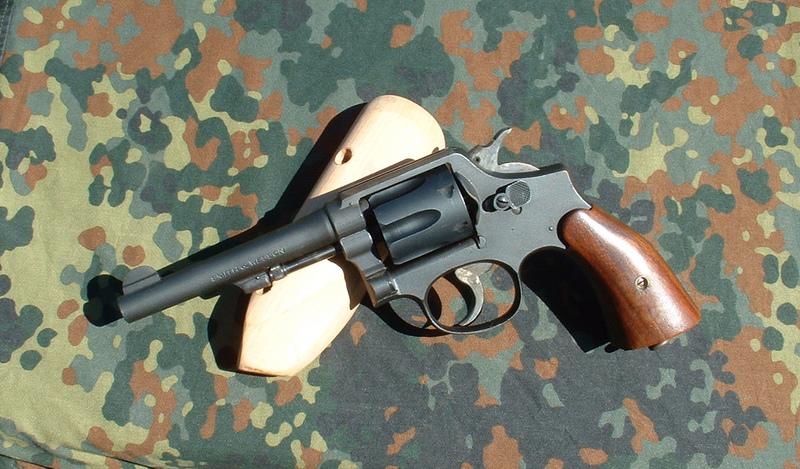-
FREE MEMBER
NO Posting or PM's Allowed

Don't remember for sure, but I believe the S&W's of that period were serial numbered on the butt, cylinder, and barrel. They also had an assembly/fitting number on the crane, on the frame under the crane, and inside the side plate. Once the revolver was fitted it had to be taken back apart for fitting, and the assembly numbers helped get the correctly fitted parts back together.
-
06-25-2014 03:39 PM
# ADS
Friends and Sponsors

-
Legacy Member


Originally Posted by
Johnny Peppers

You noted that your S&W had been rebarreled, so the serial number shown would be from the revolver the barrel was originally on. What is the serial number on the butt of your revolver?
Number on butt and cylinder is 818569
-
-
-
FREE MEMBER
NO Posting or PM's Allowed

Production started in the 800,000 range and went to 999,999 before the serial numbers started over with a V prefix. Some will argue that only the V prefix S&W's were "Victory" models, but they were all for the same purpose. Your barrel probably came from a V prefix revolver.
In my previous I had a typo. Sentence should have read:
Once the revolver was fitted it had to be taken back apart for finishing, and the assembly numbers helped get the correctly fitted parts back together.
Last edited by Johnny Peppers; 06-25-2014 at 06:51 PM.
Reason: Typo
-
Legacy Member

Well done. I do believe the poster that asked about counter boring was referring to the cylinder being opened up to take the .38 special ammo. Ihave about half a box of ammo left then I will have buy a Lee die set.
Good luck

MJ, don't take this personally, but that's crap.
muffett.2008

-
-
Legacy Member

No , counter boring is cutting the rifling out of the front of the barrel . If the rifling is damaged or worn , you can cut down to the good rifling and restore it . Counter boring preserves the external look . In this case , someone thought that the fatter than US spec British bullet would put too much pressure on the thin barrel end and thus lead to a split barrel over time . Counter boring would remove the rifling there , increasing the bore size , thus lowering the pressure there . Some early Smiths were done . Now the question I have is , by what means would an oversized slug , after passing through a forcing cone and down several inches of US spec barrel , use to pop back up to British specs in the last 1/4 inch of barrel to raise the pressure ? Others must have questioned that , too , as it did not go on long.
bullet would put too much pressure on the thin barrel end and thus lead to a split barrel over time . Counter boring would remove the rifling there , increasing the bore size , thus lowering the pressure there . Some early Smiths were done . Now the question I have is , by what means would an oversized slug , after passing through a forcing cone and down several inches of US spec barrel , use to pop back up to British specs in the last 1/4 inch of barrel to raise the pressure ? Others must have questioned that , too , as it did not go on long.
Cutting it to .38 spl is rechambering .
Chris
-














 Register To Reply
Register To Reply












